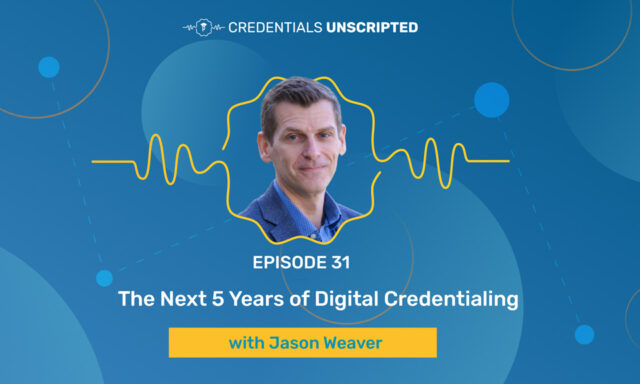
Parchment News
The Next 5 Years of Digital Credentialing
We use cookies to help you navigate efficiently and perform certain functions. You will find detailed information about all cookies under each consent category below.
The cookies that are categorized as "Necessary" are stored on your browser as they are essential for enabling the basic functionalities of the site. ...
Necessary cookies are required to enable the basic features of this site, such as providing secure log-in or adjusting your consent preferences. These cookies do not store any personally identifiable data.
Functional cookies help perform certain functionalities like sharing the content of the website on social media platforms, collecting feedback, and other third-party features.
Analytical cookies are used to understand how visitors interact with the website. These cookies help provide information on metrics such as the number of visitors, bounce rate, traffic source, etc.
Performance cookies are used to understand and analyze the key performance indexes of the website which helps in delivering a better user experience for the visitors.
Advertisement cookies are used to provide visitors with customized advertisements based on the pages you visited previously and to analyze the effectiveness of the ad campaigns.
Other cookies are those that are being identified and have not been classified into any category as yet.

Dr. Matt Liberatore is passionate about the school counselor’s role in student success, especially now. On a district level, he has been influential in collaborating with industry leaders and practitioners to define and author competencies for postsecondary advising.
Matt is the Director of Professional Learning and Student Services for Township High School District 214, President of the Illinois School Counselor Association (ISCA), and board member on the Directors of Counseling and Student Services of Suburban Chicago.
Recently, Parchment interviewed Matt to learn what was top of mind for him during the COVID-19 crisis. Here we share his thoughts on what effect the pandemic is having on high school counseling, the current challenges counselors are facing, which specific skills and competencies they are putting to work, and some lessons learned during these unprecedented times.
Identifying Students in Need
High school counselors were taxed before the pandemic, but now they have many new challenges. According to Matt, the first challenge was trying to find a way to capture which students were simply not engaged and which were struggling. “Oftentimes students are coming from a household that’s not safe, or they could be food insecure,” he explained. “Previously, the school building itself was a safe haven, but instead they may be sheltering in place in a toxic environment.”
Then there is another group of students. In Illinois, the governor’s “do no harm policy” (every state agency does something different) stipulated that whatever work was done from the third to the fourth quarter could do no harm to a student’s grade. “So, a student with an A could do nothing for the entire two months and still have an A,” said Matt. “We had to figure out which ones were truly just disengaged and which ones needed social or emotional help.”
Creating a Tiered Response System
To meet the challenge, District 214 created a multilevel system, a Google form where teachers could identify that they made a call to a student with no answer. This first-tier attempt sent an alert to the Student Services Office, informing counselors, site social workers, attendance clerks, and deans, who had a better understanding if this was an issue that needed to be escalated. “Some of the biggest challenges were communication channels, how we streamline those, make sure they were efficient, and ensure we are all going in the same direction,” Matt said.
Meeting Students Where They Are
“I think being culturally responsive in meaningful ways with students and community is key, especially meeting students where they are at,” explained Matt. “It’s so funny because I think people realize the need to do this more in a virtual environment than when they are in the building – because students are all coming to us from very different places.” For Matt, it’s first looking at Maslow’s Hierarchy of Needs: food, shelter, protection. If they don’t have those, they are not ready to learn. And even if a student has it all, they are ready to learn but are still at different levels.
“The virtual environment has allowed teachers and counselors to look at the different ways students could show competency in their work,” Matt added. “It doesn’t have to be a paper. For example, a CNA class twisted it around. Where they normally would have to work in the classroom with a mannequin, they videoed putting a parent on a stretcher, which also led to more family engagement.”
Doing What We Do (Only More Creatively)
An exciting part for Matt is that counselors can still do what they do, but they can change it up and be more creative and engaging. As a result, more family members know what’s going on with their student’s work than before. For the counselors, a larger percentage are leveraging their LMS (learning management system), realizing that it can be a great tool. “They can do a class on anxiety or postsecondary planning and load any student they want and disperses information in an efficient manner,” Matt said. “The flipped classroom is really powerful.”
Defining Counselor Skills and Competencies
For 18 months, Matt participated in a working group to define counselor skills and competencies for postsecondary advising. “If you look at the landscape of postsecondary, it’s a triad: access, success, and completion,” Matt explained. “The group felt going into this there were multiple entry points of places to give counselors more training and deeper knowledge by defining the skill set they need for postsecondary. Today, you have counselors coming into the field with all different levels of competencies.”
So, the group came together as a community of practice, with the heads of all the universities in the Chicago area that trained counselors, school counseling leaders, and practitioners. “We determined that counselors could get that knowledge in their preservice master’s program, an internship, and as professional development, once they became a working counselor,” reported Matt. “Once we decided points of entry, we looked at the existing counselor education system where organizations each had their own focus, and then articulated what competencies need to be there to increase access, success, and outcome. It was pretty awesome work!” (The ISCA published a report of the group’s recommendations in fall 2018.)
Creating an Internship Based on New Criteria
Matt is especially pleased with the special internship that District 214 created based on the defined criteria. In the past, each counselor would do his/her/their own custom thing with an intern. “I’m really proud of our first intern,” he said. “She just finished up and actually got a good job as a postsecondary counselor, which is unusual in the industry. That’s because she came out as a professional and could speak with competency about many areas. All of us in the working group are taking on pieces to invigorate what we do.”
Partnering with Eastern Illinois University
In a pre-COVID pilot based on an early advising model, the district joined with Eastern Ill University as a dual credit partner. According to Matt, students typically at risk for summer melt have a 2.5-2.9 GPA and are the first generation in their families thinking of going to EIU.
Because all the college jargon can be very confusing, the district decided to cover some of that while students are still in their senior year. “We wanted to answer questions they are going to have when they get to college but do it while they are still with us, so we can support them better,” Matt explained. For example, virtual sessions included an unpacking of a financial aid letter because most kids don’t understand what it means. Also, counselors walked through the FAFSA verification process with them. And there were other sessions like College 101 where they explained how credit hours work and another to show how to apply dual credit earned during high school.
The thing that makes this postsecondary program really special is that if a student hasn’t decided on EIU by the May 1 deadline, there’s another online session where seniors actually get to meet their EIU freshman advisor. In fact, during COVID, there were about 14 students who met their advisors. And the district helps build a 4-year EIU plan schedule for each student prior to graduation to create a seamless transition. EIU also promised to give district students priority registration among all freshmen.
Finding the Right Postsecondary Fit
Virtual tours are here to stay, according to Matt. There has to be some type of engagement, and college rep visits are more important than ever, so there’s no reason not to meet over Zoom. “I’m chairman of Directions College Fair for special education students,” he said. “We are going to have a virtual panel with a 4-year university disabilities office, credentialing program, and special ed program. I think we are going to actually engage more people this way.”
“We also had a Zoom meeting for a highly selective college fair featuring 4 different colleges with amazing honors programs,” continued Matt. “There were 200 attendees. It’s easier to jump on call than to go in person. Plus, we can record and get it out to attendees or post it. It’s key to be able to record, archive, and create a library that people can go back and review or see for the first time.”
Facilitating Freshmen Engagement
Another focus for Matt has been freshmen engagement. According to the book “The Make-or-Break Year: Solving the Dropout Crisis One Ninth Grader at a Time,” if you can get a kid on track freshman year, you are 3 times more likely not to have to intervene later on. “That year is so crucial, the most developmentally different time for an adolescent,” Matt explained. “They go from being totally reliant to having to get things done independently. So, we have to think about how we create freshmen connection and collaboration, especially now when few schools have defined what the fall experience is going to be.”
Counseling in a Post-COVID World
“In a post-COVID world, I think postsecondary counseling is going to have to be creative, provide innovative solutions, and create partnerships for a seamless transition,” Matt said. “For some of these first-generation kids whose parents may have never left home, we are going to have to include those parents and create a support community at the university before the kids even get to campus.”
How are school counselors readying themselves for fall? During the summer months, Matt is supporting a ton of summer workshops (with paid hours) to look at the district’s core counseling curriculum, including freshmen engagement, sophomore career planning, and junior postsecondary search. And how they can make those virtual in a flipped classroom with an online lesson module, some reflection pieces, and a follow up in small groups, for example.
Promoting Self-care for Wellbeing
“My hat goes off to educators who are parents of young ones!” exclaimed Matt. “You really have to practice self-care to be there for family and students. As a practicing therapist, making sure we practice self-care is a passion, especially for a giving profession like counseling. Although we are all going through something, I want to give a shout out to those with kids.”
For Matt, his self-care is fitness, the first thing he does every morning at 5 am. “It’s also small things like building breaks into my schedule for getting out and walking to my coffee place,” concludes Matt. “It’s a microtask but it creates a feeling of wellbeing. Also, I now meet weekly with a few of my college friends (whom I used to see annually) for Netflix watching and discussion. I’m looking at this time as an opportunity to connect with my network more often and deeper.”
About District 214
